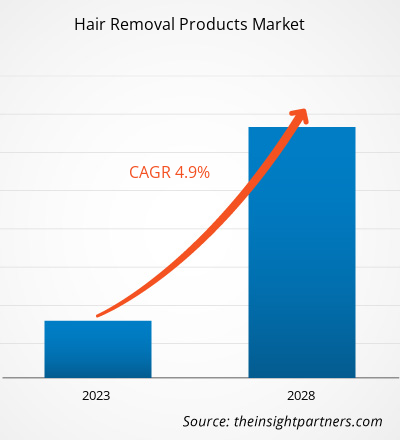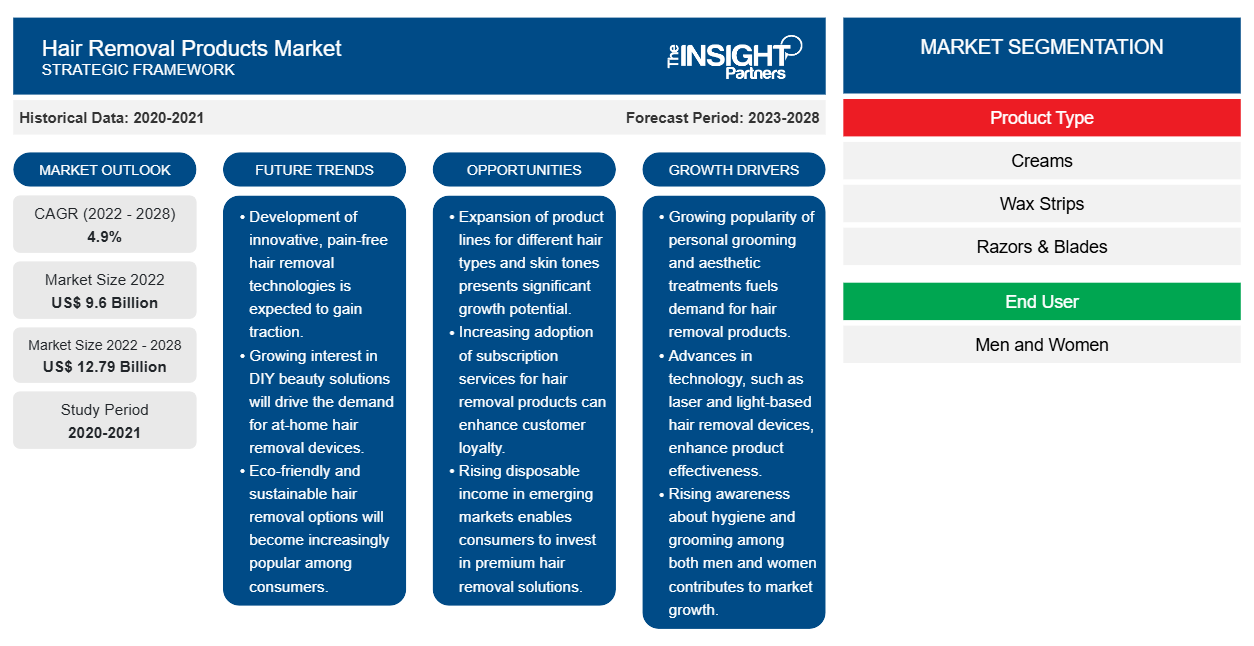[Forschungsbericht] Der Markt für Haarentfernungsprodukte soll von 9.596,39 Millionen US-Dollar im Jahr 2022 auf 12.786,19 Millionen US-Dollar im Jahr 2028 wachsen; von 2022 bis 2028 wird eine durchschnittliche jährliche Wachstumsrate (CAGR) von 4,9 % erwartet.
Haarentfernungsprodukte wie Cremes, Wachsstreifen, Rasierer und Klingen, Epilierer, Wachs, Spray, Gel und andere werden verwendet, um Haare am menschlichen Körper zu entfernen. Der globale Markt ist nach Produkttyp, Endverbraucher und Vertriebskanal segmentiert. Die steigende Bevölkerung und die hohen Verbraucherausgaben für Pflegeprodukte, insbesondere bei Männern, treiben die Nachfrage nach Haarentfernungsprodukten in verschiedenen Regionen an.
Der globale Marktanteil von Haarentfernungsprodukten im asiatisch-pazifischen Raum war im Jahr 2022 der größte. Nach Ländern unterteilt sich der Markt für Haarentfernungsprodukte im asiatisch-pazifischen Raum in Australien, China, Indien, Japan, Südkorea und den Rest des asiatisch-pazifischen Raums. Der Einfluss der sozialen Medien, die Bevölkerungszunahme und das gestiegene Bewusstsein für trendige Mode- und Stilaussagen dürften den regionalen Markt im Prognosezeitraum ankurbeln. Daher konzentrieren sich die wichtigsten Marktteilnehmer in der Region auf die Entwicklung innovativer und erschwinglicher Haarentfernungsprodukte, um die Kundenanforderungen zu erfüllen. Darüber hinaus wird erwartet, dass die Einführung verschiedener Wachstumsstrategien wie Partnerschaften, Forschung und Entwicklung, Marketingkampagnen und Übernahmen das Marktwachstum für Haarentfernungsprodukte in der Region in den kommenden Jahren ankurbeln wird. Im Jahr 2022 startete Koninklijke Philips NV die Kampagne „Wonder of You“, um sein Segment der Selbstgesundheitspflege in Asien zu erweitern.
Passen Sie diesen Bericht Ihren Anforderungen an
Sie erhalten kostenlos individuelle Anpassungen an jedem Bericht, einschließlich Teilen dieses Berichts oder einer Analyse auf Länderebene, eines Excel-Datenpakets sowie tolle Angebote und Rabatte für Start-ups und Universitäten.
-
Holen Sie sich die wichtigsten Markttrends aus diesem Bericht.Dieses KOSTENLOSE Beispiel umfasst eine Datenanalyse von Markttrends bis hin zu Schätzungen und Prognosen.
Auswirkungen der COVID-19-Pandemie auf den Markt für Haarentfernungsprodukte
Vor der COVID-19-Pandemie war die Nachfrage nach Haarentfernungsprodukten hauptsächlich auf die hohen Verbraucherausgaben für Pflegeprodukte und die steigende Nachfrage nach Haarentfernungsprodukten für Männer zurückzuführen. Mehrere Branchen verlangsamten jedoch im Jahr 2020 ihren Betrieb aufgrund von Störungen der Wertschöpfungsketten, die durch die Schließung nationaler und internationaler Grenzen als Reaktion auf die COVID-19-Pandemie verursacht wurden. Die Pandemie verursachte ein globales Gesundheitschaos, das das Funktionieren aller Branchen, einschließlich der Konsumgüterindustrie, störte. Der Verkauf verschiedener Haarentfernungsprodukte ging aufgrund der Schließung von Salons zurück. Gleichzeitig gab es einen Anstieg des Datenverkehrs auf E-Commerce -Websites und mehr Verbraucher begannen, Produkte online zu kaufen. Im Jahr 2021 stieg die Nachfrage nach Haarentfernungsprodukten mit der Wiederaufnahme der Geschäftstätigkeit und der Aufhebung der Lockdown-Maßnahmen sprunghaft an, was im Prognosezeitraum lukrative Möglichkeiten für den Markt für Haarentfernungsprodukte bieten dürfte.
Markteinblicke
Steigende Nachfrage nach Haarentfernungsprodukten für Männer
Der Anstieg globaler Werbekampagnen für Haarentfernungsprodukte hat die Kundenperspektive vom Friseursalon hin zur Körperpflege zu Hause verschoben. Darüber hinaus rasieren sich Männer häufiger im Gesicht und entfernen unerwünschte Körperhaare häufiger als Frauen. Männer verwenden im Allgemeinen Rasierer und Klingen zur Gesichtshaarentfernung oder zum Trimmen und bevorzugen Haarentfernungscremes oder -sprays zur Entfernung unerwünschter Körperhaare. Die veränderte Einstellung der Männer zur Körper- oder Selbstpflege hat die Hersteller dazu ermutigt, Produkte zu entwickeln, die speziell auf die Hauttypen und -anforderungen von Männern abgestimmt sind. So brachte die Reckitt Benckiser Group plc 2019 die Veet-Haarentfernungscreme-Reihe für Männer auf den Markt, die Veet Men Normal und Veet Men Sensitive umfasst. Darüber hinaus bieten verschiedene Unternehmen ihren Kunden Abonnements für Rasierer oder Haarentfernungssets an, bei denen das Unternehmen ihnen in einem vom Kunden festgelegten regelmäßigen Intervall Haarentfernungssets direkt an die Haustür liefert. So bieten Unternehmen wie Harry's, Dollar Shave Club und The Procter & Gamble Company Abonnementboxen zur Haarentfernung an. Die steigende Nachfrage nach Körperpflegeprodukten für Männer wie Haarschneidemaschinen, Elektrorasierern, Rasierapparaten , Klingen und Haarentfernungscremes treibt das Wachstum des Marktes für Haarentfernungsprodukte an.
Einblicke in Produkttypen
Basierend auf dem Produkttyp ist der globale Markt für Haarentfernungsprodukte in Cremes, Wachsstreifen, Rasierer und Klingen, Epilierer und andere unterteilt. Das Segment Rasierer und Klingen hatte 2022 den größten Marktanteil. Rasierer und Klingen werden verwendet, um Haare von der Hautoberfläche zu entfernen. Bei diesem Vorgang werden die Haare nicht ausgerissen. Die Haarentfernung mit Rasierern und Klingen ist eine bequeme und zeitsparende Methode und wirkt auch als Peeling, um abgestorbene Hautzellen zu entfernen. Rasierer sind in verschiedenen Ausführungen erhältlich, beispielsweise Systemrasierer, Sicherheitsrasierer und Elektrorasierer.
Church & Dwight Co., Inc.; Reckitt Benckiser Group plc; Oriflame Holding AG; GIGI; American International Inc.; Procter & Gamble; Koninklijke Philips NV; Sally Hansen; Si & D (Aust) (Pty) Ltd; und Revitol Corp Players sind einige Akteure auf dem Markt für Haarentfernungsprodukte. Diese Marktteilnehmer konzentrieren sich darauf, qualitativ hochwertige Produkte anzubieten, um die Kundennachfrage zu erfüllen. Sie verfolgen auch Strategien wie Investitionen in Forschungs- und Entwicklungsaktivitäten, die Einführung neuer Produkte, Kooperationen sowie Fusionen und Übernahmen.
Bericht-Spotlights
- Fortschrittliche Branchentrends auf dem Markt für Haarentfernungsprodukte helfen den Akteuren bei der Entwicklung wirksamer langfristiger Strategien
- In Industrie- und Entwicklungsländern angewandte Strategien für Unternehmenswachstum
- Quantitative Analyse des Marktes für Haarentfernungsprodukte von 2020 bis 2028
- Schätzung der weltweiten Nachfrage nach Haarentfernungsprodukten
- Porters Fünf-Kräfte-Analyse zur Veranschaulichung der Wirksamkeit der in der Branche tätigen Käufer und Lieferanten
- Aktuelle Entwicklungen zum Verständnis des Wettbewerbsmarktszenarios
- Markttrends und -aussichten sowie Faktoren, die das Wachstum des Marktes für Haarentfernungsprodukte vorantreiben und bremsen
- Unterstützung im Entscheidungsprozess durch Aufzeigen von Marktstrategien, die das kommerzielle Interesse untermauern und zum Marktwachstum führen
- Marktgröße für Haarentfernungsprodukte an verschiedenen Knotenpunkten
- Detaillierte Übersicht und Segmentierung des Marktes sowie der Dynamik der Haarentfernungsproduktebranche
- Größe des Marktes für Haarentfernungsprodukte in verschiedenen Regionen mit vielversprechenden Wachstumschancen
Globaler Markt für Haarentfernungsprodukte
Nach Produkttyp ist der globale Markt für Haarentfernungsprodukte in Cremes, Wachsstreifen, Rasierer und Klingen, Epilierer und andere unterteilt. Basierend auf dem Endverbraucher ist der Markt in Männer und Frauen unterteilt. Der globale Markt für Haarentfernungsprodukte ist basierend auf dem Vertriebskanal in Supermärkte und Hypermärkte, Convenience Stores, Online-Einzelhandel und andere unterteilt.
Regionale Einblicke in den Markt für Haarentfernungsprodukte
Die regionalen Trends und Faktoren, die den Markt für Haarentfernungsprodukte während des Prognosezeitraums beeinflussen, wurden von den Analysten von Insight Partners ausführlich erläutert. In diesem Abschnitt werden auch die Marktsegmente und die Geografie von Haarentfernungsprodukten in Nordamerika, Europa, im asiatisch-pazifischen Raum, im Nahen Osten und Afrika sowie in Süd- und Mittelamerika erörtert.

- Erhalten Sie regionale Daten zum Markt für Haarentfernungsprodukte
Umfang des Marktberichts zu Haarentfernungsprodukten
| Berichtsattribut | Details |
|---|---|
| Marktgröße im Jahr 2022 | 9,6 Milliarden US-Dollar |
| Marktgröße bis 2028 | 12,79 Milliarden US-Dollar |
| Globale CAGR (2022 - 2028) | 4,9 % |
| Historische Daten | 2020-2021 |
| Prognosezeitraum | 2023–2028 |
| Abgedeckte Segmente |
Nach Produkttyp
|
| Abgedeckte Regionen und Länder |
Nordamerika
|
| Marktführer und wichtige Unternehmensprofile |
|
Dichte der Marktteilnehmer für Haarentfernungsprodukte: Die Auswirkungen auf die Geschäftsdynamik verstehen
Der Markt für Haarentfernungsprodukte wächst rasant, angetrieben von der steigenden Nachfrage der Endverbraucher aufgrund von Faktoren wie sich entwickelnden Verbraucherpräferenzen, technologischen Fortschritten und einem größeren Bewusstsein für die Vorteile des Produkts. Mit steigender Nachfrage erweitern Unternehmen ihr Angebot, entwickeln Innovationen, um die Bedürfnisse der Verbraucher zu erfüllen, und nutzen neue Trends, was das Marktwachstum weiter ankurbelt.
Die Marktteilnehmerdichte bezieht sich auf die Verteilung der Firmen oder Unternehmen, die in einem bestimmten Markt oder einer bestimmten Branche tätig sind. Sie gibt an, wie viele Wettbewerber (Marktteilnehmer) in einem bestimmten Marktraum im Verhältnis zu seiner Größe oder seinem gesamten Marktwert präsent sind.
Die wichtigsten auf dem Markt für Haarentfernungsprodukte tätigen Unternehmen sind:
- Church & Dwight Co., Inc.
- Reckitt Benckiser Group plc
- Oriflame Holding AG
- GIGI
- American International Inc.
Haftungsausschluss : Die oben aufgeführten Unternehmen sind nicht in einer bestimmten Reihenfolge aufgeführt.

- Überblick über die wichtigsten Akteure auf dem Markt für Haarentfernungsprodukte
Firmenprofile
- Church & Dwight Co., Inc.
- Reckitt Benckiser Group plc
- Oriflame Holding AG
- GIGI
- American International Inc.
- Procter & Gamble
- Koninklijke Philips NV
- Sally Hansen
- Si & D (Aust) (Pty) Ltd
- Revitol Corp
- Historische Analyse (2 Jahre), Basisjahr, Prognose (7 Jahre) mit CAGR
- PEST- und SWOT-Analyse
- Marktgröße Wert/Volumen – Global, Regional, Land
- Branchen- und Wettbewerbslandschaft
- Excel-Datensatz
Aktuelle Berichte
Verwandte Berichte
Erfahrungsberichte
Grund zum Kauf
- Fundierte Entscheidungsfindung
- Marktdynamik verstehen
- Wettbewerbsanalyse
- Kundeneinblicke
- Marktprognosen
- Risikominimierung
- Strategische Planung
- Investitionsbegründung
- Identifizierung neuer Märkte
- Verbesserung von Marketingstrategien
- Steigerung der Betriebseffizienz
- Anpassung an regulatorische Trends























 Kostenlose Probe anfordern für - Markt für Haarentfernungsprodukte
Kostenlose Probe anfordern für - Markt für Haarentfernungsprodukte